If you’re anything like me, chances are you’ve spent a few hours lost in the TikTok time warp. The good news is, you’re definitely not alone. Statista estimates that TikTok will reach 834 million active users during 2023. But, have you ever wondered why certain content is showing up in your feed over other videos? It’s all about TikTok SEO.
TikTok SEO is the process of maximizing your content’s visibility within the app’s search algorithm. Much like traditional SEO, there are specific techniques and strategies that can boost how your content ranks. If you’re a TikTok creator yourself, you may have been doing TikTok SEO without even knowing it! But in any case, this strategy has become increasingly popular to help display your content over everything else the app has to offer.
Let’s take a closer look at what exactly TikTok SEO is, its similarities to traditional SEO, and how you can put it to use today to start maximizing your content’s visibility.
TikTok is a Search Engine
When you start to start to pull apart the different technical aspects of how TikTok functions, it’s perfectly reasonable to label it as a search engine. Outside of its For You Page (FYP) that we all know and love, the way you find content on the app is primarily through its search feature. You input a keyword or phrase, and TikTok returns the most relevant videos that match your query. TikTok also tacks on an auto-fill feature while you’re searching, just like Google’s Autocomplete.
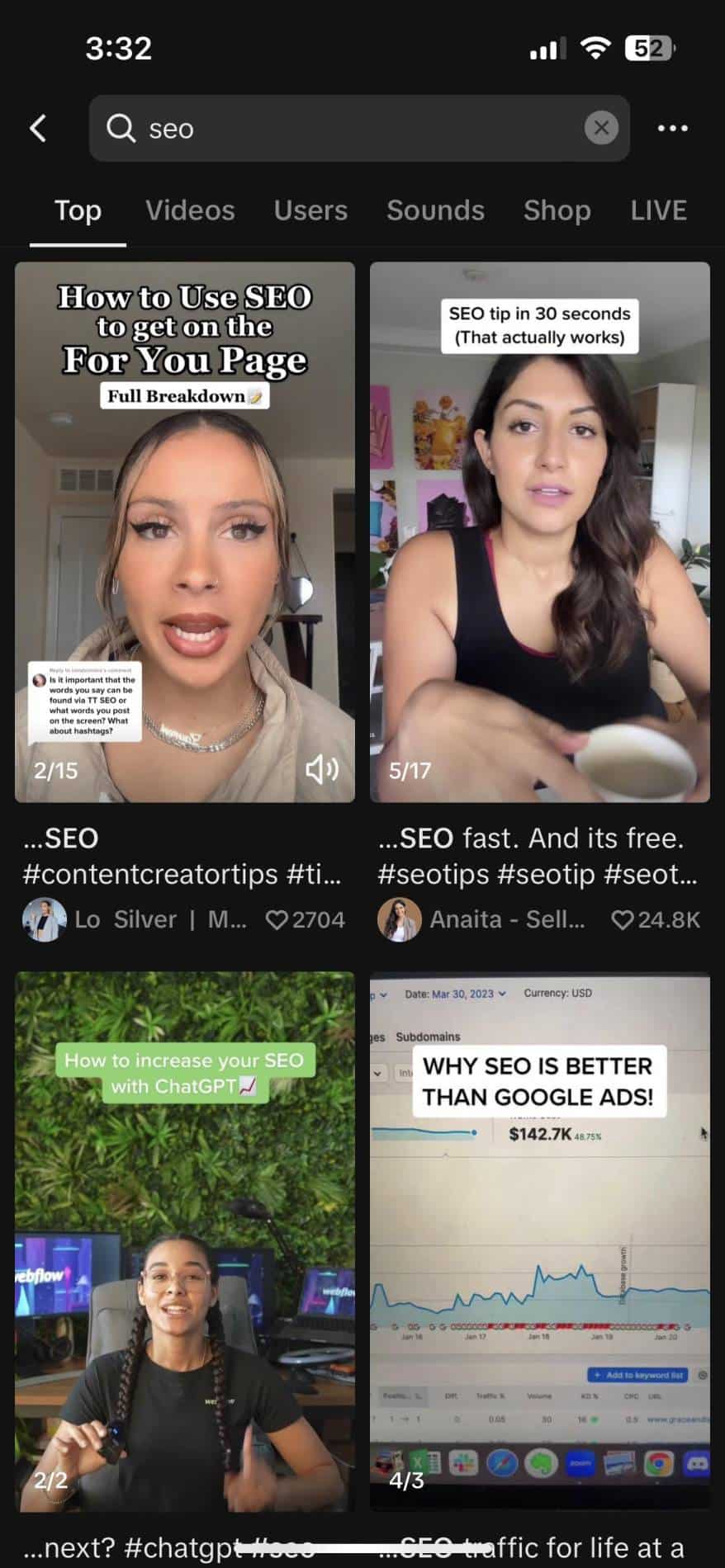
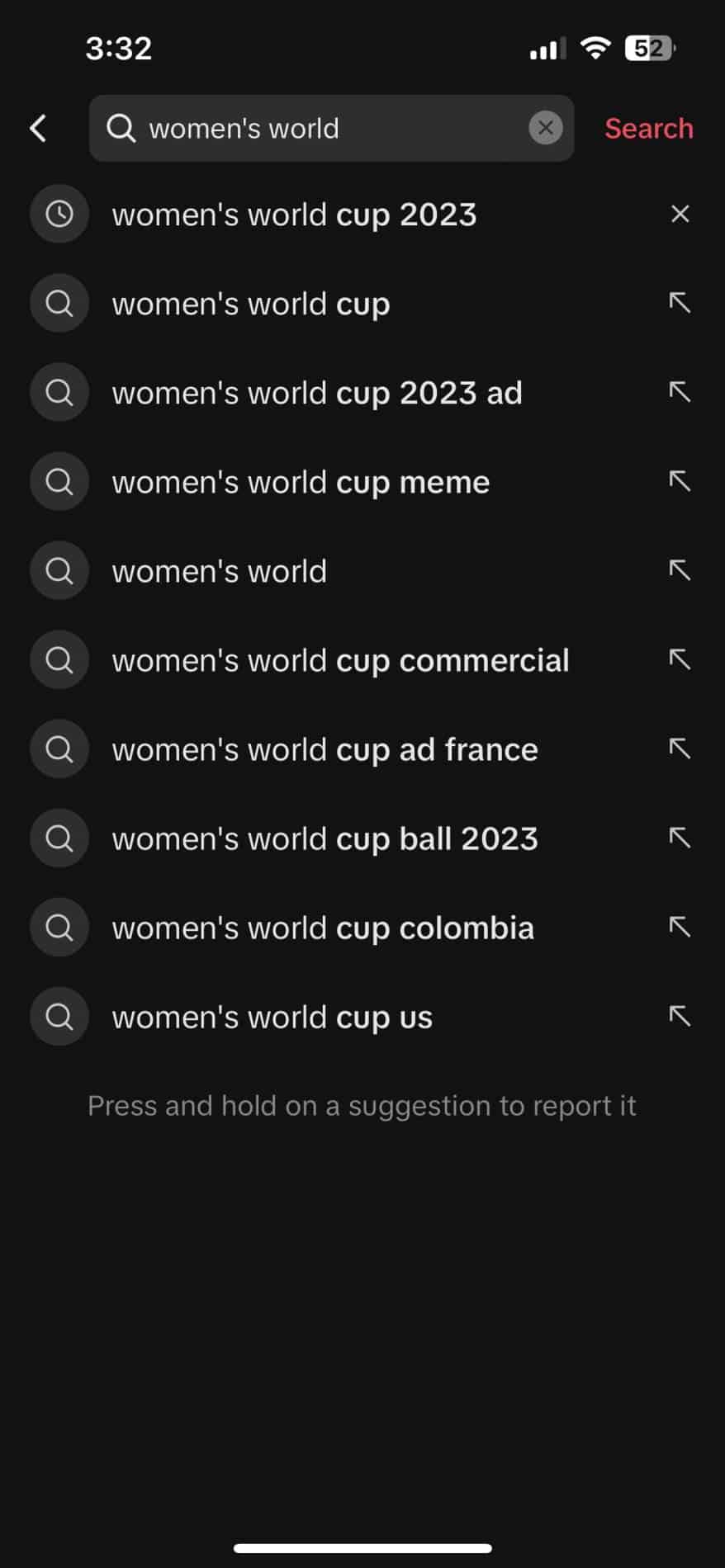
TikTok’s search page (left) functions very similarly to popular search engines like Google, including the search bar itself (right).
Sound familiar? It should, because even Google has publicly acknowledged that TikTok is eating away at their market share. Instead of going to Google to make their search, users are navigating to TikTok to find engaging and interactive responses for the same exact queries.
According to user interviews conducted by Euronews, the app’s users – especially Gen Z – find TikTok’s content to be more personalized and “real” compared to what you find on a traditional search engine like Google. And with plenty of content to choose from, users are also finding joy diving deep into different topics they’re interested in without much effort.
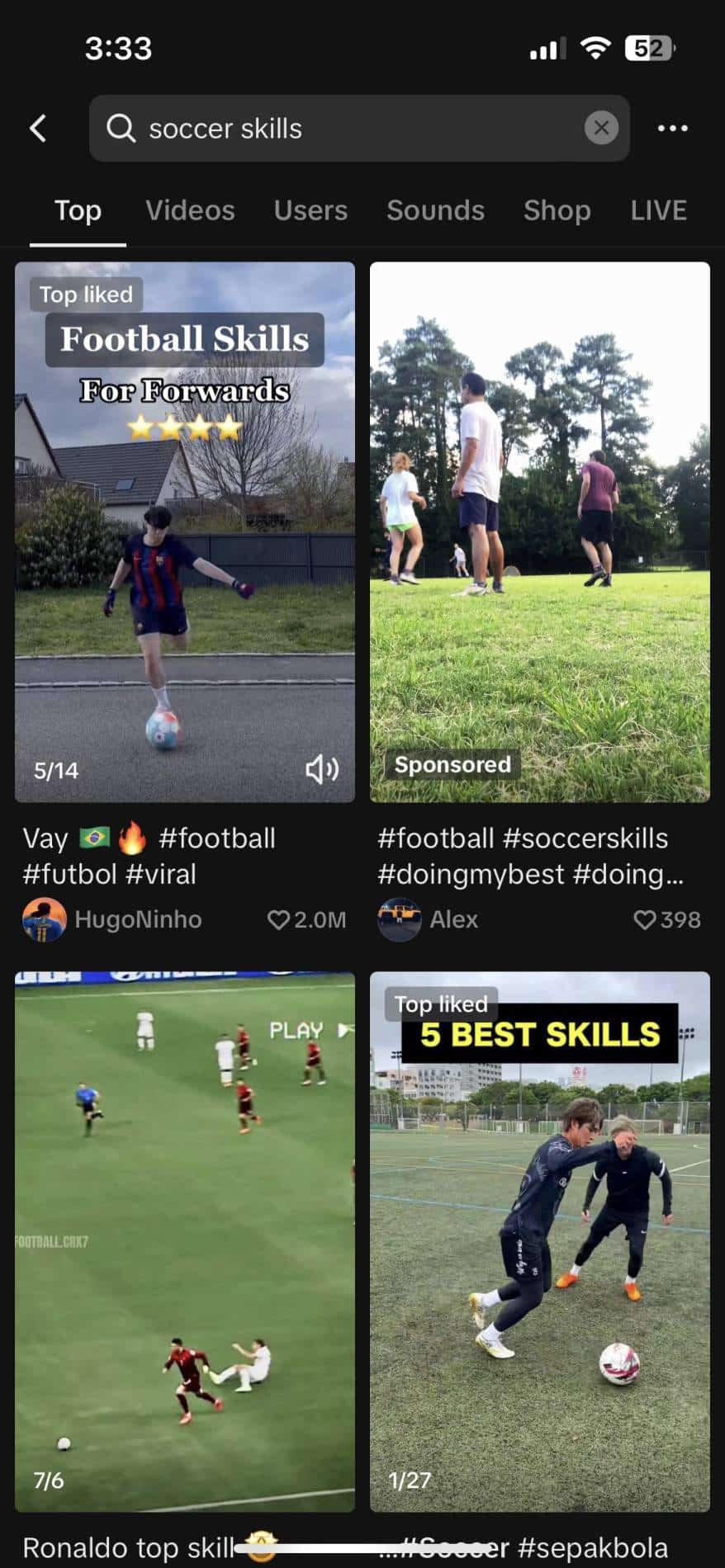
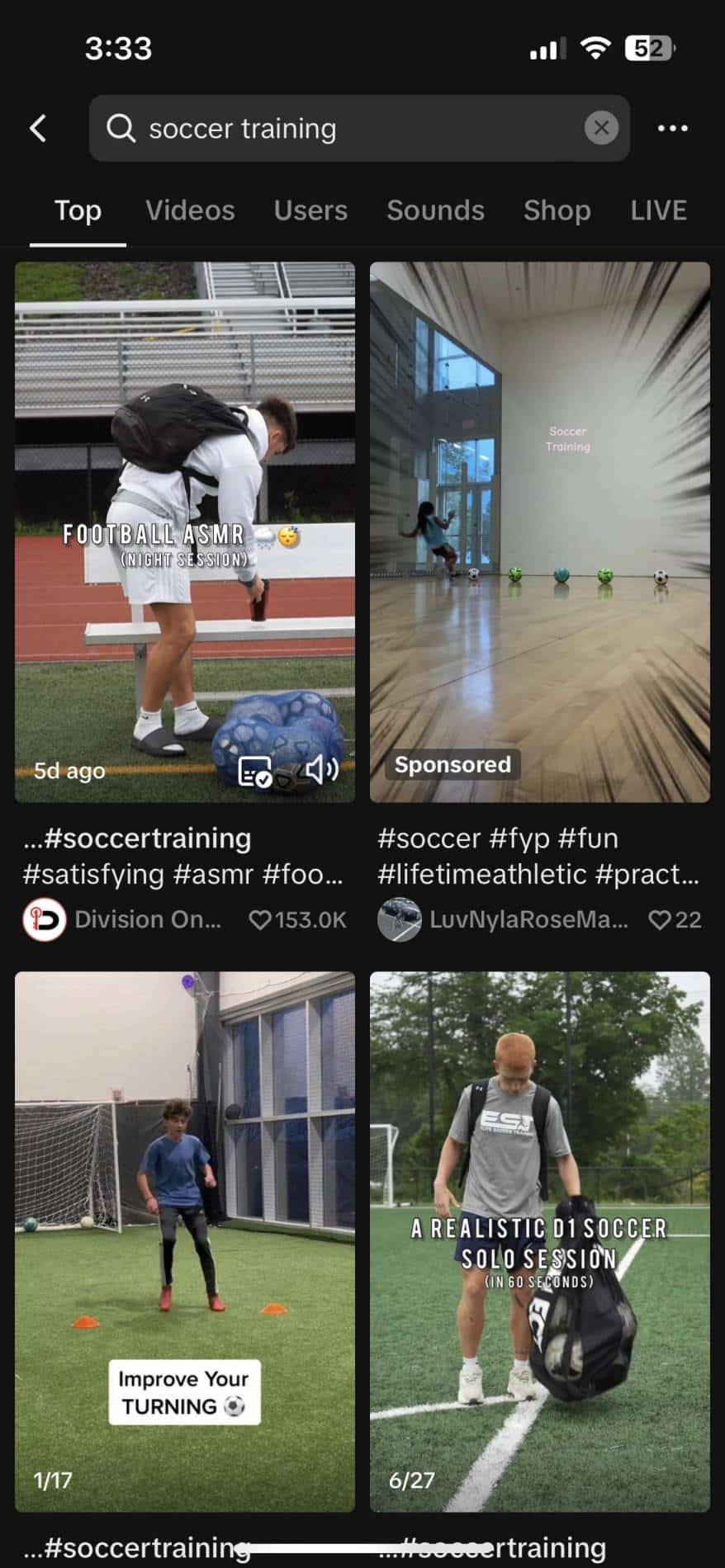
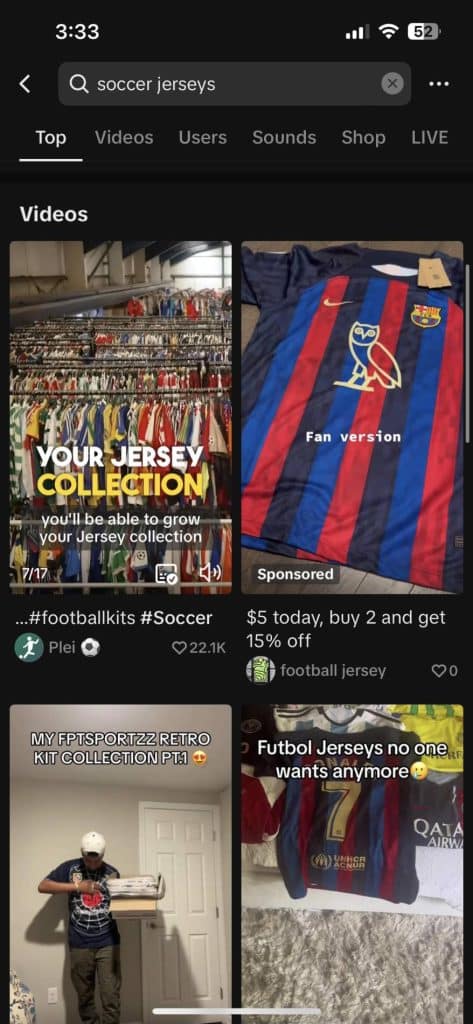
To get an idea of how niche you can go in different topics, here are three unique categories within the topic of soccer.
Starting in the fall of 2022, Google responded to TikTok’s growth by adding new features to Search and Maps in an effort to re-engage with the younger generation of searchers. And although Alphabet’s most recent quarterly earnings showed no signs of decline, it’s still unclear whether they’re recapturing the market share they’ve lost to TikTok. But if Sundar Pichai is viewing TikTok as a serious search engine, so should you.
TikTok SEO vs. Traditional SEO
Now that we’ve established that TikTok is a search engine, it’s important to distinguish how you optimize your content compared to traditional SEO.
The Type of Content Being Optimized
The biggest difference between TikTok SEO and traditional SEO is the type of content being optimized. In traditional SEO, the focus is mostly on optimizing written text to respond to user needs. But when optimizing content to perform well on TikTok, we’re obviously going to be more concerned about video content.
So, if you’re an SEO who’s use to optimizing landing pages and editorial posts for specific keywords, then optimizing content on TikTok will be a slightly different challenge.
How the Algorithms “Rank” Content
TikTok’s search algorithm functions differently than the major web-based search engines like Google, in that TikTok’s AI-powered algorithm is powered to show users unique content that aligns with their interests. By analyzing engagement metrics like the accounts, they follow and what content they like or comment on most often, the algorithm will serve a different set of videos to pretty much every user every time the app is opened.
In contrast to traditional search engines, the way in which organic results are listed is based on ranking — how well the algorithm perceives a particular landing page as being “optimized” relative to a search query. Results can also vary based on regular algorithm updates (which are usually announced by Google) and locality, which are two areas in which traditional SEO has a leg up on TikTok.
Although traditional organic results are not hyper-specific to each searcher’s needs, they are set up to be streamlined to reduce the amount of time someone is searching to find the information they need. And with new AI-powered features like Google’s Search Generative Experience on the horizon, the way traditional search engines tackle TikTok’s popularity will only improve over time.
How Users Discover Content
For the past 20 years, the primary way users have discovered content on traditional search engines is by typing in a keyword that aligns with their search intent. With the introduction of social content like TikTok, users can discover content in various ways without having to ever make a proper search.
In TikTok’s case, users typically discover content first on their FYP which is a totally hands-off experience. Once users get a sense for what trends or creators they’re interested in from what they see on their FYP, they’ll turn to the app’s Search page to browse specific hashtags and keywords that align with what they want to see more of.

How to Optimize Your TikTok Videos
Even though TikTok and traditional search engines prioritize content differently, the tactics behind optimizing content on either platform are roughly the same.
How you optimize your content on TikTok ultimately boils down to what niche you’re a part of. The way a beauty influencer formats their videos will be inherently different compared to how an Excel guru will structure theirs.
But in general, there are five high-level areas you can keep in mind when optimizing your video content for TikTok.
1. Keyword Research
Researching the right keywords and topics to center your video around will always be important, no matter which search engine algorithm you’re optimizing for. Without proper research, it’s nearly impossible to adequately serve the needs and intent of your target audience. You may have some solid ideas about which keywords they’re searching for based on the niche you operate in, but it’ll be tough to just guess the full “keyword universe” your audience is using to find content just like yours.
On TikTok, it’s no different. Well-known keyword research tools like Semrush and Google Ads’ Keyword Planner can help you pinpoint keywords that your TikTok audience is searching for. It isn’t a perfect solutionsince those tools don’t track TikTok data, but metrics like search volume and keyword intent will still be directionally accurate.
Additionally, TikTok’s Creative Center also offers their own Keyword Insights tool. The user interface (UI) will look very familiar to most SEOs who’ve used tools like Semrush in the past. But instead of search volume, the Keyword Insights tool measures keywords based on Popularity – the total number of ads that are using a specific keyword in all active business campaigns.
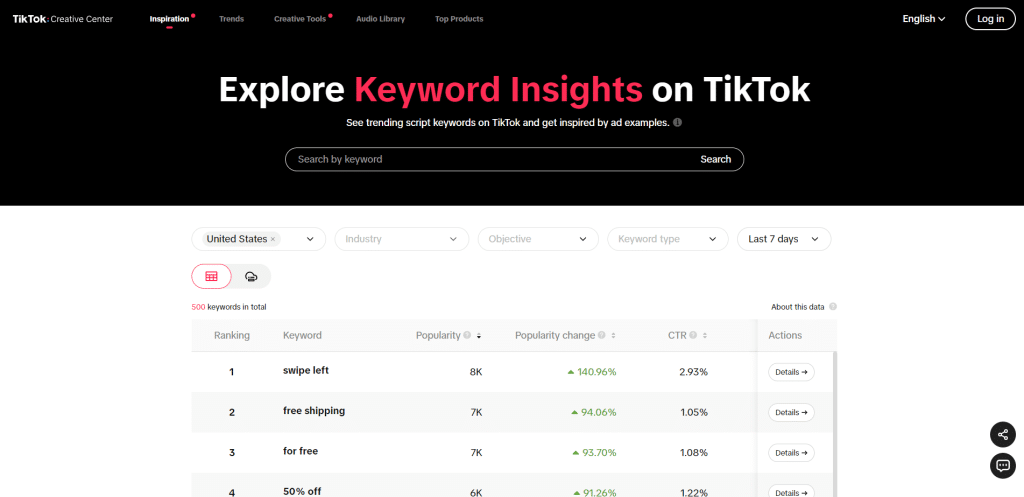
So while you won’t get a sense of how many searches everyday users are making with the Keyword Insights tool, you will get to gauge which keywords are most valuable based on how many businesses are advertising toward them. The Creative Center also provides a similar tool for Hashtags, Songs, and Creators, so you can take your research beyond keywords alone.
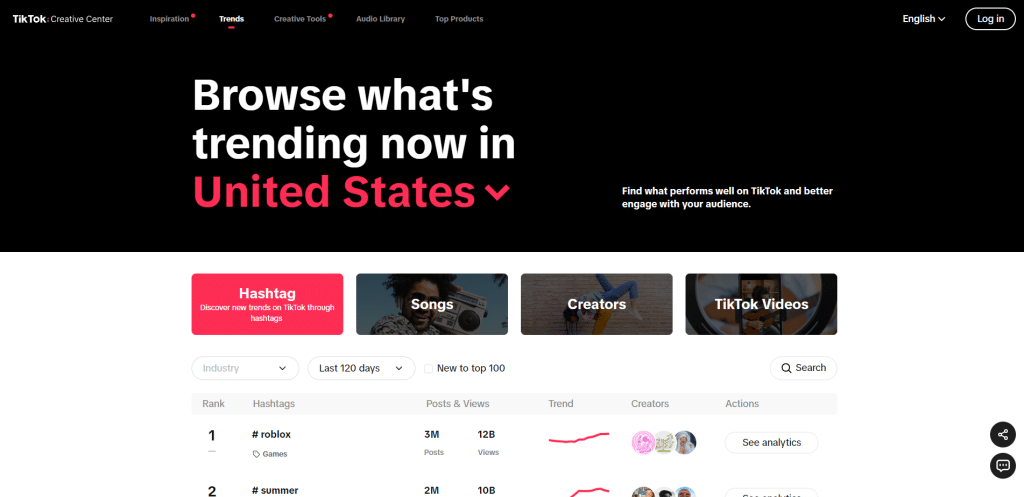
2. Caption Optimization
After you find the right keywords for your content creation efforts, it’s time to actually slot them into your videos. Currently, there’s five ways to incorporate written text into a TikTok video:
- In-video text like text overlays
- Speech
- Captions
- Hashtags
- Automated closed captions
The most overlooked area in that list is captions. TikTok’s search algorithm takes your caption content into account in determining how relevant your video is to a certain query. Coincidentally, most creators fail to optimize their captions to their full potential.
When creating a caption, you should always include:
- Your keyword (and/or a close variation)
- A hashtag(s) relevant to your video’s topic
- A call-to-action like asking viewers to like, comment, or subscribe, if your video content calls for it
TikTok allows up to 2,200 characters within a single caption, so don’t be afraid to get creative and add in additional content like emojis, thought-provoking questions for your audience to respond to in the comments, and tagging other accounts if your video features other TikTok users.
For a picture-esque breakdown of how to structure your video captions, check out this video from Morgan Branding:
@morganbranding Caption example to BEAT TikTok SEO!🥊🚀🔥 #tiktokseo #tiktokforbusiness #smallbiztiktoktips #tiktokgrowthtips #tiktokstrategist #tiktokcontentcreator #smallbiztips #tiktokcoach ♬ original sound - Marketing & TikTok Agency 🚀
3. Text Overlay
Text overlay is another key written element to consider when optimizing video content for TikTok. Text overlay is any written text that gets superimposed on top of your video while it’s playing. Creators often use text overlay to highlight important parts of their video or incorporate it as a narrative piece.
Unlike captions and hashtags, text overlay does not play a significant role in how TikTok’s algorithm perceives a video. However, they do act as unique storytelling and engagement elements for your target audience. In general, it’s best that your captions are:
- Succinct and readable. Ensure that the text is clear, legible, and to the point. Nobody wants to read entire paragraphs – try to stick to just a few words at a time.
- Relevant to your video. Your text overlay should complement the content of your video and add value to their viewer’s experience.
- Highlight key points. If your video contains a few key points that you want the audience to remember, you can reinforce them by using text overlay. Highlights also come in handy for users that might be watching your video without sound as they can still takeaway your key points.
- Well placed. Experiment with your text overlay to ensure that it doesn’t obstruct key content within your video. Although the best placement will vary from video to video, placing text overlay at the bottom or top of the screen is usually the best.
- Well timed. Additionally, experiment with when your text overlay appears in your video. This will ensure that the text appears and disappears at the right time.
@themakeshiftproject Guess the TOP 5 MOST POPULAR FOODS IN AMERICA!! #fyp #top5 #food #america #usa #fooktok ♬ 7AM (Slowed + Reverb) - adrian
The makers of the Makeshift Project Podcast often use text overlay to compliment the context of their discussions.
4. Spoken Words
The words that are spoken in a TikTok video – usually referred to as the “audio” or “sounds” — are very much its “body content”, similar to how SEOs think of the written words in an editorial article. It’s important to optimize your video’s caption and text overlay, but optimizing what you say in your video will ultimately make-or-break its success.
How you go about optimizing your spoken content will depend on who your audience is and what tone of voice you’re trying to achieve.
If you’re managing a business account and want to promote a specific product or service, you may opt to write a script beforehand to read along during your video. But if you’re a podcast host who posts episode snippets to your TikTok channel, your spoken words will most likely be unscripted and feel more natural.
Sounds
Keep in mind that spoken words don’t have to necessarily come from the people in your video. There’s also the possibility of not saying any actual words in your video and just letting the sound do the talking.
Sounds are firmly attached to the virality of TikTok, in that sounds can “trend” in the same way that dances or viral challenges do. They’re usually a snippet of a song or another person talking, but anyone can create a sound using any kind of audio.
Since sounds are templated once a user creates them, there’s no way to “optimize” them for your videos. It’s usually wise to pick a sound that’s trending at the time of posting since users will be familiar with it already. Most content creators use that as a safe rule of thumb.
But in any case, just make sure that the sound you choose (if any) is appropriate for your audience.
5. Trends
Everybody loves trends! From dances to cooking to sports, pretty much every life topic has had its own trend on TikTok at some point. They’re usually easy to spot since every trend will have its own set of hashtags and sounds. And from personal experience, I can attest that they can be really easy to spot if your entire FYP is filled with videos from a specific trend.
Trends don’t last forever, so content creators will capitalize on them whenever they can in an attempt to go viral. But as any marketer will tell you, it’s painfully tough to get a piece of content to go viral. But luckily for TikTok users, the app’s algorithm has a natural way of pushing out content to a wide range of users to make it go viral.
When leveraging current trends in your content creation efforts, make sure to keep these tips in mind:
- Use trending sounds. TikTok’s algorithm tends to push videos that use trending sounds over content that uses a random audio. A good place to find trending sounds is the Songs report in TikTok’s Creative Center. But you can also search “trending sounds” within the app’s Search page, filter the results by recency, and see a list of sounds that are currently trending.
- Use relevant hashtags. Similar to sounds, hashtags can also trend based on what type of content is popular. Choosing a trending hashtag is key for improving your video’s discoverability within the app’s Search page. Using the Hashtags report in TikTok’s Creative Center, you can spot which hashtags are most relevant to both your video’s content and your target audience.
- Use trending keywords. Also ensure that your video’s written and spoken content contains a relevant target keyword. Without it, the algorithm will have trouble recognizing that your video is meant to be a part of a trend – and your viewers likely won’t pick up on it either.
- Avoid promotional content. Everyone loves trends, but not everyone loves being sold something when they didn’t ask for it. When creating content for a trend, it’s usually best to leave the sales pitch at home. Some brands have gotten around this with some smart creatives, but when done poorly, it can leave a long-lasting negative effect on your brand’s reputation. Stick to what people are looking for – entertainment and engagement.
For more on optimizing your content for trends, check out these tips and tricks from social media guru Amber Henry:
@thesocial.bff How to go viral on tiktok in 2023! #contentcreator #thesocialbff #influencertips #microinfluencertips #howtogrowontiktok #tiktokgrowth2023 #9to5 #beginnercontentcreator #socialmediastrategy #blackgirlcontentcreator #tiktokgrowth #seo #keywordoptimization #viralvideo ♬ original sound - THE SOCIAL BFF
Frequently Asked Questions
TikTok uses a personalized recommendation system algorithm to determine the videos you see within the app. The algorithm is designed to give users interesting and engaging content so that they spend more time on the platform compared to other social media apps.
In a nutshell, TikTok’s algorithm uses a combination of user data, machine learning, content evaluation, and engagement metrics to determine what content shows up in each user’s feed.
TikTok’s algorithm decides what to show you based on what you’ve interacted with in the past such as videos, accounts, hashtags, sounds, and the types of videos you’ve personally created.
Amongst many other factors, the algorithm also uses your user settings (i.e., country and language) to serve relevant content, as well as the interest categories you select when first opening the app on a new account.
The exception is if you turn on features such as Consent Mode and/or Signal data. See the sections above for more information.
You can view how many times your content appears in the For You Page by viewing your account analytics. Currently, this feature is only available to TikTok Pro accounts, so most users won’t be able to see this information.
If you have a TikTok Pro account, head to your profile and click on Settings & Privacy in your account settings. Then, click Creator Tools and find the Analytics page. Once you’re there, you’ll see a “Content” tab at the top of the page. The “Content” tab will show you all of your videos from the last 7 days.
Click on any video to see its viewing analytics, which includes a “Traffic Source Types” chart. The FYP is labeled “For You” in that chart, so you can see the percentage of users who viewed your content there compared to other sources.
Even though TikTok has been around for a few years now, there’s still lots of confusion and untapped potential when it comes to optimizing content to perform well.
If you’re interested in creating content on the app, you can put these tips to work today and start pushing out quality and engaging content. Or if you’re more a lurker like myself, you’ll start to build a real-time understanding of why certain content shows up in your feed.
Have any other tips and tricks that the TikTok world show know? Let us know in the comments below!

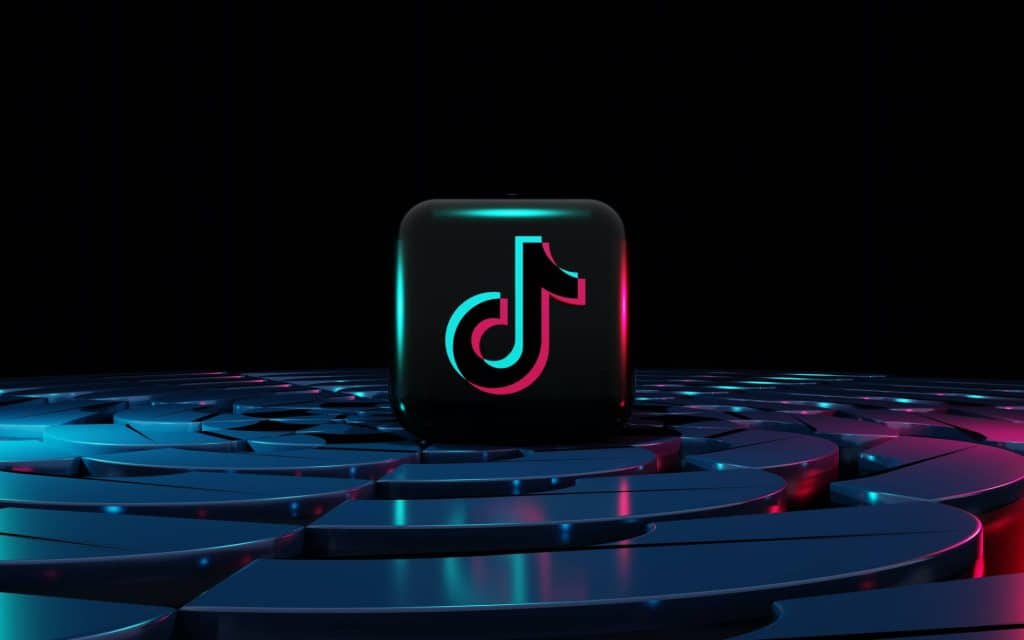








2 Comments
Great post! TikTok SEO is a fascinating topic. It’s amazing how optimizing content with relevant hashtags, keywords, and trending sounds can significantly boost visibility on the platform. As more users turn to TikTok for discovery, mastering these SEO strategies becomes essential for creators and brands aiming to reach a larger audience. Thanks for the insights!
Thank you! TikTok SEO is indeed a powerful tool for boosting reach—glad you found the strategies insightful!